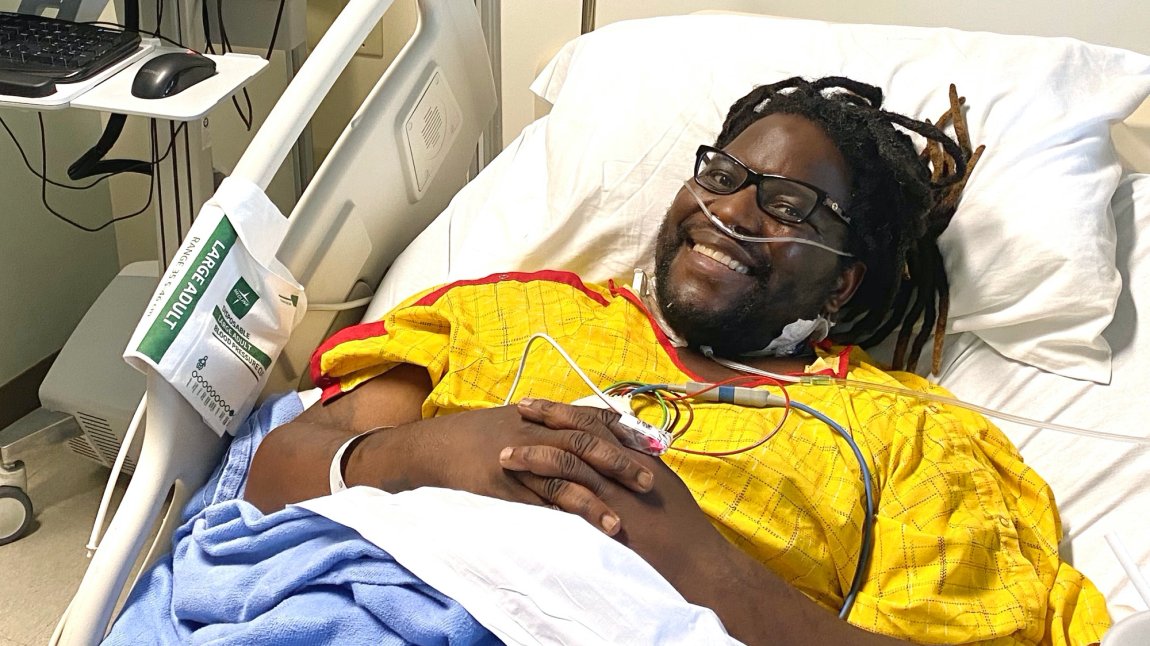COVID-19 is a strange virus. And James Simpson’s battle with COVID is the strangest Dr. Jason Prasso has seen.
“We thought he was going to die,” said Prasso, a pulmonary and critical care specialist who oversaw James' care since the day he was admitted to the intensive care unit at the Martin Luther King, Jr. Community Hospital (MLKCH).
“His case has been a humbling experience. What it made us realize is just how unpredictable this disease is.”
James, 40, should be dead. During his time in the MLKCH intensive care unit, his lungs, kidneys, liver and circulatory systems all failed. There were serious discussions with his family about taking him off life support.
Instead, after two and a half weeks in a medically-induced coma, he woke up. He cried. The first words out of his mouth were for his caregivers.
“Thank you,” he said. “You saved my life.”
ICU doctors and nurses are trained to manage their emotions, but even so, “I teared up,” said Maria Arechiga, one of James' nurses. “It was very touching.”
It is also a demonstration that even in a high-risk, highly vulnerable community, high-quality medical care can work miracles.
Vulnerable
The odds are not in your favor if you contract COVID-19 as an African American. Nationally, African Americans are disproportionately more likely to get COVID-19 than any other racial or ethnic group. They are also more likely to be hospitalized with severe symptoms. In California, African American patients ages 18 to 49 are dying nearly two and a half times as often as their share of the state’s population.
Death from COVID-19 is closely correlated with pre-existing health conditions. Those conditions—diabetes, asthma, obesity, heart disease—are often found in majority-minority places like South LA, which have suffered for years from too few doctors and a lack of healthy food outlets, education, and resources.
James Simpson is emblematic of the types of challenges many people in medically-underserved communities face. He is technically obese, with a prior history of chronic disease. At the time he fell sick, he was living in a group home, with little ability to socially distance himself from others. He is low income. He is African American.
On March 16, James came to the MLKCH emergency department complaining of fever, chills, cold sweats and fatigue—all classic symptoms of COVID-19.
His memory ends at the hospital’s front door. He woke up nearly a month later in the intensive care unit with IV lines plugged into his neck and a ventilator tube down his throat.
“It was so scary,” James recalled. “It was horrible.”
His caregivers do not disagree.
“I don’t think anyone thought he would make it,” said Maria, his nurse. “It makes it an even better feeling that he is where he is, and that we contributed to that.”
James was admitted to the hospital the day he came in. At first he stayed in a regular hospital room, monitored by nurses. On March 21—as often and inexplicably happens with COVID patients—he crashed.
“There’s just a lot of things that are curious about this disease,” said Dr. Prasso. “It can happen fast. It can happen slow. We have patients who have been in the hospital for a week and a half before they have to be intubated. We had a 36 year old patient in good health who was dead within 4 days. There’s no predicting it.”
